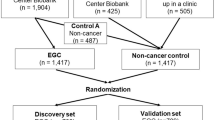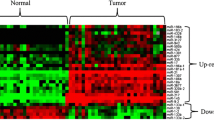Abstract
Gastric cancer (GC) is one of the most threatening diseases. The symptoms of GC are complex and hard to detect, which also contribute to the poor prognosis of GC. Besides, the current diagnosis for GC is expensive and invasive. Thus, a fast, noninvasive biomarker is urgently needed for GC screening. MicroRNAs (miRNAs) are small noncoding RNAs, which are involved in a great variety of pathological processes, particularly carcinogenesis. MiRNAs are stable in gastric juice, plasma as well as serum, which facilitate it to be a promising biomarker for cancer. In this study, we selected three novel miRNAs, i.e., miR-233, miR-16, and miR-100, to investigate their potential diagnostic value in GC screening. A total of 50 GC patients and 47 healthy controls were involved in this study. Blood serum samples were collected; RNAs were extracted and normalized with U6 snRNA as the internal control; qRT-PCR was performed for relative expression of target miRNAs. Levels of miRNAs expression were compared by Student’s t test for the comparison between two groups, and one-way ANOVA was used for multiple comparisons. The expression of miR-223, miR-16, and miR-100 was all significantly higher in GC patients than controls (all P < 0.001). All the tested miRNAs were manifested to be valuable biomarkers for GC. Relative expression of these miRNAs was significantly correlated with clinical characteristics of GC patients, such as TNM stage (P = 0.036 for miR-223; P < 0.001 for miR-100), metastatic status (P = 0.045 for miR-223; P = 0.031 for miR-16; P = 0.006 for miR-100), tumor size (P = 0.042 for miR-223; P = 0.031 for miR-16; P < 0.001 for miR-100), and differentiation grade (P = 0.036 for miR-223; P = 0.030 for miR-16; P = 0.034 for miR-100). However, in T classification, which considered both tumor size and direct extent of primary tumor, the difference in target miRNAs expression was not significant. In summary, we confirmed the diagnostic value of serum miR-223, miR-16, and miR-100 in GC. Significantly elevated expression of the three miRNAs was also observed in advanced GC patients, which suggested their availability in cancer staging.




Similar content being viewed by others
References
Siegel R, Ma J, Zou Z, Jemal A. Cancer statistics, 2014. CA Cancer J Clin. 2014;64(1):9–29.
Jemal A, Bray F, Center MM, Ferlay J, Ward E, Forman D. Global cancer statistics. CA Cancer J Clin. 2011;61(2):69–90.
D’Angelo G, Di Rienzo T, Ojetti V. Microarray analysis in gastric cancer: a review. World J Gastroenterol. 2014;20(34):11972–6.
Ebert MP, Rocken C. Molecular screening of gastric cancer by proteome analysis. Eur J Gastroenterol Hepatol. 2006;18(8):847–53.
Ha M, Kim VN. Regulation of microRNA biogenesis. Nat Rev Mol Cell Biol. 2014;15(8):509–24.
Rasheed SAK, Teo CR, Beillard EJ, Voorhoeve PM, Casey PJ. microRNA-182 and microRNA-200a control G-protein subunit α-13 (GNA13) expression and cell invasion synergistically in prostate cancer cells. J Biol Chem. 2013;288(11):7986–95.
Valeri N, Braconi C, Gasparini P, Murgia C, Lampis A, Paulus-Hock V, et al. microRNA-135b promotes cancer progression by acting as a downstream effector of oncogenic pathways in colon cancer. Cancer Cell. 2014;25(4):469–83.
Yang Y, Peng W, Tang T, Xia L, Wang XD, Duan BF, et al. MicroRNAs as promising biomarkers for tumor-staging: evaluation of miR21 miR155 miR29a and miR92a in predicting tumor stage of rectal cancer. Asian Pac J Cancer Prev. 2014;15(13):5175.
Wittekind C, Asamura H, Sobin LH. TNM Atlas. London: John Wiley & Sons; 2014.
Cui L, Zhang X, Ye G, Zheng T, Song H, Deng H, et al. Gastric juice microRNAs as potential biomarkers for the screening of gastric cancer. Cancer. 2013;119(9):1618–26.
Li C, Li JF, Cai Q, Qiu QQ, Yan M, Liu BY, et al. MiRNA-199a-3p in plasma as a potential diagnostic biomarker for gastric cancer. Ann Surg Oncol. 2013;20(3):397–405.
Cai H, Yuan Y, Hao Y-F, Guo T-K, Wei X, Zhang Y-M. Plasma microRNAs serve as novel potential biomarkers for early detection of gastric cancer. Med Oncol. 2013;30(1):1–7.
Nishizawa T, Suzuki H. The role of microRNA in gastric malignancy. Int J Mol Sci. 2013;14(5):9487–96.
Mishra S, Lin CL, Huang TH, Bouamar H, Sun LZ. microRNA-21 inhibits p57Kip2 expression in prostate cancer. Mol Cancer. 2014;13(1):212.
Ma J, Yao Y, Wang P, Liu Y, Zhao L, Li Z et al. MiR-152 functions as a tumor suppressor in glioblastoma stem cells by targeting Kruppel-like factor 4. Cancer Lett. 2014;355(1):85–95.
Leung CM, Tsai KW, Pan HW. DNA methylation in aggressive gastric carcinoma. 2013;223–242. doi:10.5772/52135.
Crone SG, Jacobsen A, Federspiel B, Bardram L, Krogh A, Lund AH, et al. microRNA-146a inhibits G protein-coupled receptor-mediated activation of NF-kappaB by targeting CARD10 and COPS8 in gastric cancer. Mol Cancer. 2012;11:71.
Ma L, Chen Y, Zhang B, Liu G. Increased microRNA-223 in Helicobacter pylori-associated gastric cancer contributed to cancer cell proliferation and migration. Biosci Biotechnol Biochem. 2014;78(4):602–8.
Kang W, Tong JH, Chan AW, Lung RW, Chau SL, Wong QW, et al. Stathmin1 plays oncogenic role and is a target of microRNA-223 in gastric cancer. PLoS One. 2012;7(3):e33919.
Li J, Guo Y, Liang X, Sun M, Wang G, De W, et al. microRNA-223 functions as an oncogene in human gastric cancer by targeting FBXW7/hCdc4. J Cancer Res Clin Oncol. 2012;138(5):763–74.
Li X, Zhang Y, Zhang H, Liu X, Gong T, Li M, et al. MiRNA-223 promotes gastric cancer invasion and metastasis by targeting tumor suppressor EPB41L3. Mol Cancer Res. 2011;9(7):824–33.
Shin VY, Jin H, Ng EK, Cheng AS, Chong WW, Wong CY, et al. NF-kappaB targets miR-16 and miR-21 in gastric cancer: involvement of prostaglandin E receptors. Carcinogenesis. 2011;32(2):240–5.
Xia L, Zhang D, Du R, Pan Y, Zhao L, Sun S, et al. MiR-15b and miR-16 modulate multidrug resistance by targeting BCL2 in human gastric cancer cells. Int J Cancer J Int Du Cancer. 2008;123(2):372–9.
Sun H, Meng X, Han J, Zhang Z, Wang B, Bai X, et al. Anti-cancer activity of DHA on gastric cancer–an in vitro and in vivo study. Tumour Biol. 2013;34(6):3791–800.
Wang M, Ren D, Guo W, Wang Z, Huang S, Du H, et al. Loss of miR-100 enhances migration, invasion, epithelial-mesenchymal transition and stemness properties in prostate cancer cells through targeting Argonaute 2. Int J Oncol. 2014;45(1):362–72.
Peng H, Luo J, Hao H, Hu J, Xie SK, Ren D, et al. microRNA-100 regulates SW620 colorectal cancer cell proliferation and invasion by targeting RAP1B. Oncol Rep. 2014;31(5):2055–62.
Shi DB, Xing AY, Gao C, Gao P. Expression of microRNA-100 in human gastric cancer. Zhonghua Bing Li Xue Za Zhi Chin J Pathol. 2013;42(1):15–9.
Mroczek S, Dziembowski A. U6 RNA biogenesis and disease association. Wiley Interdiscip Rev RNA. 2013;4(5):581–92.
Acknowledgments
This work was supported by a grant from National Natural Science Foundation of China (Grant No. 81101504.
Conflict of interest
The authors declare that they have no conflict of interest.
Author information
Authors and Affiliations
Corresponding authors
Additional information
H. Wang, L. Wang and Z. Wu are the co-first authors.
Rights and permissions
About this article
Cite this article
Wang, H., Wang, L., Wu, Z. et al. Three dysregulated microRNAs in serum as novel biomarkers for gastric cancer screening. Med Oncol 31, 298 (2014). https://doi.org/10.1007/s12032-014-0298-8
Received:
Accepted:
Published:
DOI: https://doi.org/10.1007/s12032-014-0298-8




